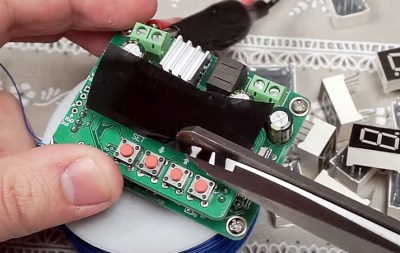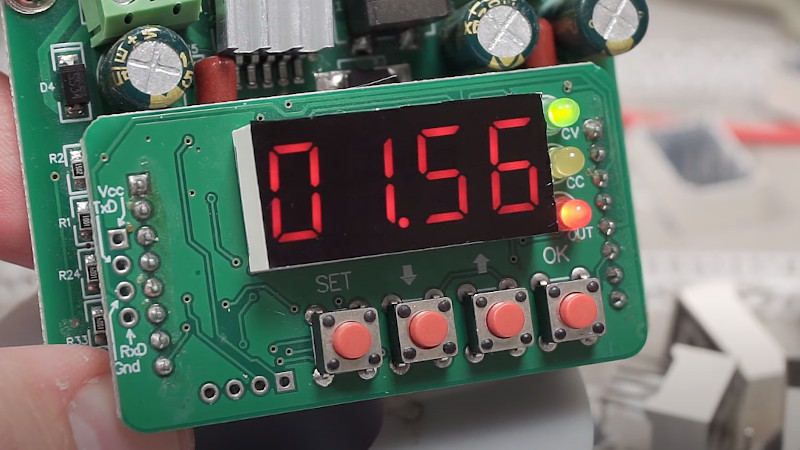We’re suckers for a nice seven-segment LED display around these parts, and judging by how often they seem to pop up in the projects that come our way, it seems the community is rather fond of them as well. But though they’re cheap, easy to work with, and give off that all important retro vibe, they certainly aren’t perfect. For one thing, their visibility can be pretty poor in some lighting conditions, especially if you’re trying to photograph them for documentation purposes.

If this is a problem you’ve run into recently, [Hugatry] has a simple tip that might save you some aggravation. With a scrap piece of automotive window tint material, it’s easy to cut a custom filter that you can apply directly to the face of the display. As seen in the video, the improvement is quite dramatic. The digits were barely visible before, but with the added contrast provided by the tint, they stand bright and beautiful against the newly darkened background.
[Hugatry] used 5% tint film for this demonstration since it was what he already had on hand, but you might want to experiment with different values depending on the ambient light levels where you’re most likely to be reading the display. The stuff is certainly cheap enough to play around with — a quick check seems to show that for $10 USD you can get enough film to cover a few hundred displays. Which, depending on the project, isn’t nearly as overkill as you might think.















This is why commercial products tend to use a red film over the LED displays. Don’t people tear things apart anymore?
He mentions that in the video.
I’ve done this in the past for those MAX7219 LED matrices. The film is cheap, widely available and conveniently self adhesive.
Back in the 70s I used to use Strand Electric primary red stage lighting gel, sold as “cinemoid” for this.
The stage lighting gel should have the bonus of not melting if you swapped all the surface mount LED for surface mount laser diodes :-D
Just right now, at my company we’re nearing mass production of a household product with a 7-segment display on the UI, and have a tinted acrylic ‘lens’ in front of the modules to improve contrast, except the build samples we received from the build house were way too lightly tinted, leading to poor visibility. Waiting on the next batch to see if it’s correct… it really does make a huge difference.
Same idea as how Sony CRT TVs used smoked glass back in the day to improve contrast….
We only seem to see clear and green and blue tints of PET bottles around here, not the brown and orange that can be common in other areas (Though I guess if I looked harder I might come up with something) which would probably do in a pinch if you don’t have anything else handy.
Oh yeah, don’t forget to check your junk drawers and crap collector nooks and crannies for a pair of anaglyph red/blue 3D glasses…. you might get enough material for two strips of 4 characters if you peel them apart carefully.
But if we do that how are going to be ready for vr for the masses.
You could also use the translucent red tape sold for quick repair of broken taillight lenses.
Incidentally, you could use this (red tape or black film) on other kinds of display, not just 7 segment, which might produce an interesting effect or cause the displayed information to stand out more.
(Obviously not very suitable for something displaying full color images.)
My thought exactly.
I wonder if using a simple white electrostatic film as used to clear-masking windows woud do the trick for RGB displays ….
Great tip. In an earlier life, I worked on the graphics for the next gernatipn (Patrick Stewart) Star Trek bridge set. The transparent plexiglass that the backlits were mounted behind were not clear but a light brown ish tint. The graphics have gone into trek lore as okudagrams (my boss).
Not really a hack. Sorry.
It’s a simple hack, to be sure, but it’s using a product for a purpose other than its intended purpose. I’d say that counts as a hack.
People have been using candy wrappers and other materials for decades. It’s only really a hack if it’s new or innovative.
I call BS on this one.
Chocolate and sweets used to have a tinted cellophane wrap usually over a separate foil wrapper.. You can buy rolls of tinted cellophane for wrapping gifts.
I meant to call BS on not calling this a hack. Who cares if it has been done before?
Wow, who pissed in your Cheerios this morning? The idea of using window tint film for this is new to me, so I appreciate the article.
It’s a hack, and a good one too. He used something he had laying around, to greatly improve something else. Original, who cares? That’s not really the point of hacking. Probably, most hacks were done before, and never shared, or forgotten by most. It’s good to share, rather than worry about originality, or impressing those of little imagination.
Thank god we have the grand lord of hacks here to tell us what in his holy opinion is a hack and what is not … /sarcasm. Seriously think about wasting your time doing something at least a little more productive than parroting the “not a hack” mantra.
3M Auto Lens Repair Film should work OK. You can buy at Walmart.
Or 3M Lens Repair Tape
https://i5.walmartimages.com/asr/7a66133c-d480-4fe3-929b-f3d687828272.6700b7546acb157e5f182c4abb0ae7fb.jpeg?odnHeight=612&odnWidth=612&odnBg=FFFFFF
https://www.youtube.com/watch?v=gMFsazPValw
Back in the early 80’s, I did something similar using part of an anti-static bag.
I was running into this issue a while ago for some small clocks I was making. I was going through a lot of work to design a 3D printable enclosure which would house an 8mm thick piece of red tinted PMMA plastic. After a lot of pain trying to make it printable, I ended up realizing that I could just print the cases in red and make a thin layer of case over where the display would go. Depending on the layer and wall thickness, I could vary how much diffusion the case added to the display–less for a small 7 segment display, more for an 8×32 array of LEDs. The case for the 7 segment is done and looks great. I’m still working on the design for the 8×32 array, but it’s just a matter of time.
The best part of the design is that nothing extra is required and it’s simple than the original design that required the cut pieces of filter plastic. Now, of course, I have these large sheets of 8mm red PMMA and no use for them. :)
LED’s ave improved quite dramatically in the last 50 years, but blocking 95% of their light still seems a bit much.
Is it 5% transmittance or 5% attenuation? Because if this film is meant to tint car windows it seem highly unlikely it’s the former and not the latter.
It’s 5% transmittance, very dark as tint films go. As mentioned in the video you could just as easily go with lighter stuff, which would indeed improve the brightness, at the expense of some contrast.
What I have done for a cool factor look was use one way mirror film.
Still not a hack.
Maybe using a Sharpie to darken each segment would be a hack, but not this. This is just doing what everyone has done since, like, forever, man.
You might do some good with a sharpie from the backside of the segment assembly… to try to isolate each segment more and block bleedover between them which makes the contrast poor. YMMV on that depending on the exact style of the housing.
You should do this with polarizing filter, this filter eat about 50% of light instead of 95% with “solar foil”.
If you plan to buy something, I can recommend Lee filters.
There is a sample booklet of filters – sufficient for trying out which ones you like most for your application – and then buying a larger piece will not cost that much. Apart from colored “gels” there is also diffusion and darkening films available.
The filters are heat resistant (meant for installation in studio lamps), can easily be cut and are readily available in the event industry. Thomann in Europe has them
Hi, this method gives a very good effect to the project
But I have a question, for a black box that has a seven-segment display, would putting the seven-segment behind a plexiglass screen be as beautiful?